23 Most Beautiful Mountains In The United States
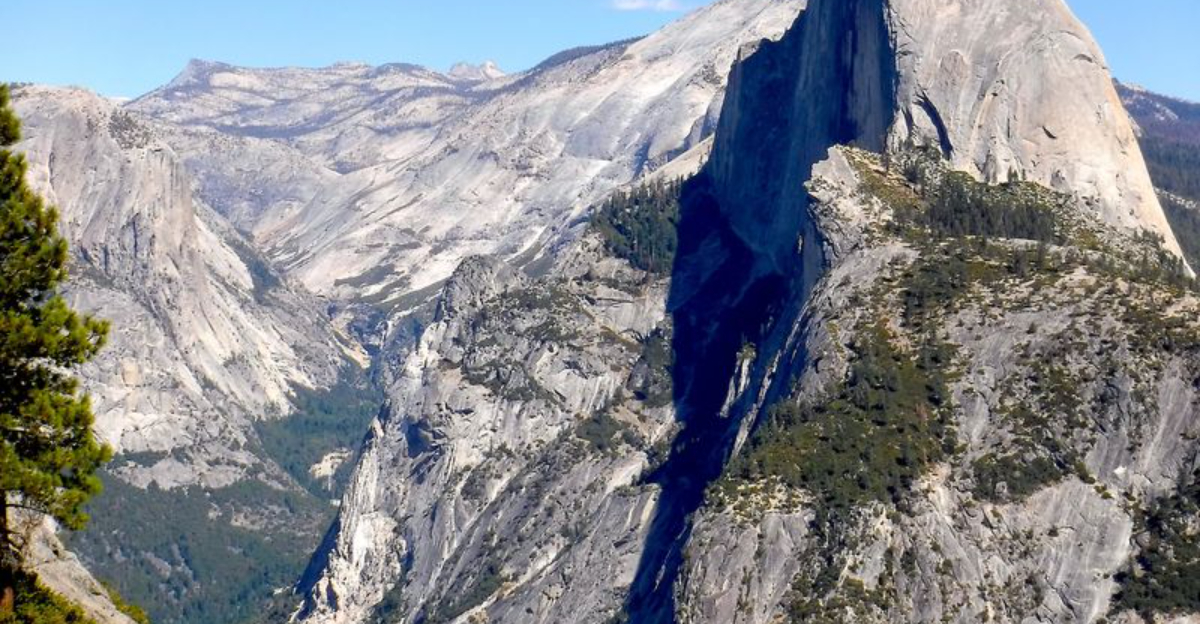
The U.S. is a paradise for mountain lovers, and each range has its own personality. Have you ever stood in front of a snow-dusted peak and just felt small—in the best way?
From the jagged drama of the Tetons to the quiet strength of the Blue Ridge Mountains, these 23 peaks are more than scenic—they’re soul-stirring. Some are perfect for a challenging hike, while others beg to be admired with a hot drink in hand from a cozy cabin window.
I’ve chased sunrises in the Rockies and lost track of time wandering through alpine meadows in the Cascades. And each time, I’ve come away feeling like I got a little closer to the heart of the wild. Which peak will call to you?
1. Denali (Mount McKinley)

Standing tall at 20,310 feet, Denali reigns as North America’s highest peak. Located in Alaska’s Denali National Park, this magnificent mountain creates its own weather patterns and ecosystems.
I’ve found that the best views come during the clearer summer months when the mountain emerges from its typical cloud cover. Wildlife thrives around its base, with grizzly bears, wolves, and moose roaming freely.
Did you know Denali means “the high one” in the native Athabascan language? The mountain’s massive size is even more impressive considering it rises from a relatively low base, giving it a greater vertical relief than even Mount Everest!
2. Grand Teton
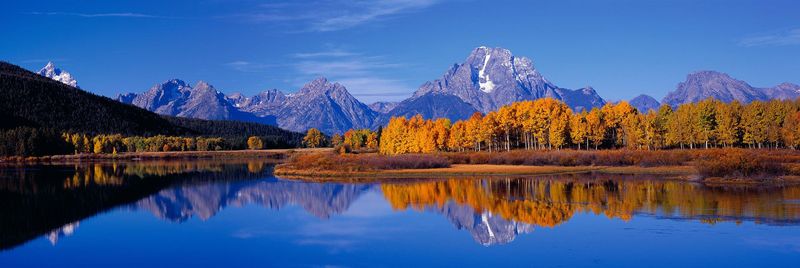
Without any gentle foothills to ease its rise, Grand Teton dramatically shoots up from the Jackson Hole valley floor in Wyoming. This jagged 13,775-foot peak seems to pierce the sky, creating one of America’s most recognizable mountain profiles.
The surrounding Grand Teton National Park offers incredible hiking trails that bring you face-to-face with alpine lakes reflecting the mountain’s image. Moose and elk frequently appear in meadows below the peaks.
Photographers flock here year-round, but fall brings a special magic when aspen trees turn golden against the mountain’s rugged gray face. The Teton Range is actually one of the youngest mountain ranges in North America, still actively rising today!
3. Mount Rainier
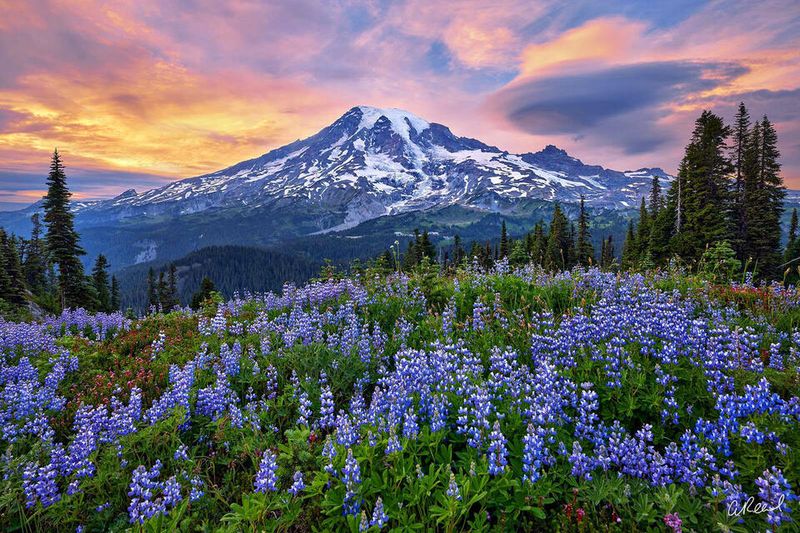
Watching over Seattle like a silent guardian, Mount Rainier stands as an active volcano capped with 25 glaciers. Its massive 14,411-foot peak dominates the skyline on clear days, seeming to float above the clouds.
Wildflower meadows explode with color during summer months, creating a rainbow carpet at the mountain’s base. The park surrounding Rainier offers over 260 miles of maintained trails for hikers of all skill levels.
Though beautiful, Rainier demands respect – it’s considered one of the most dangerous volcanoes in the world due to its potential for eruption and massive glaciers. Native Americans called it “Tahoma,” meaning “the mountain that is god,” a fitting name for this awe-inspiring peak.
4. Maroon Bells
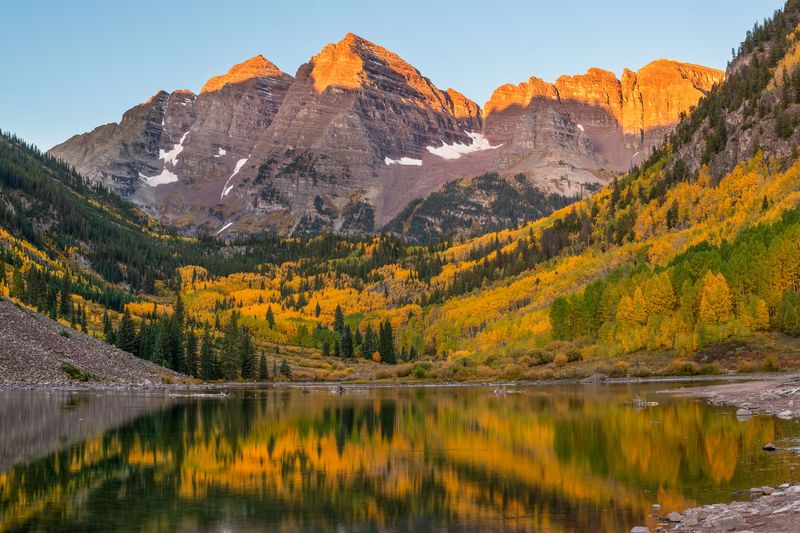
Often called the most photographed mountains in North America, the Maroon Bells present a perfect pairing of 14,000-foot peaks reflected in the crystal-clear Maroon Lake. These distinctive mountains near Aspen, Colorado get their maroon color from the weathered mudstone that makes up their slopes.
When autumn arrives, the surrounding aspen groves turn brilliant gold, creating a scene so beautiful it seems almost unreal. Morning light brings the best views, casting a warm glow across the peaks before most visitors arrive.
Though they look peaceful, mountaineers nicknamed them the “Deadly Bells” due to the unstable rock that makes climbing dangerous. The surrounding wilderness area offers spectacular hiking through some of Colorado’s most pristine landscapes.
5. Mount Whitney
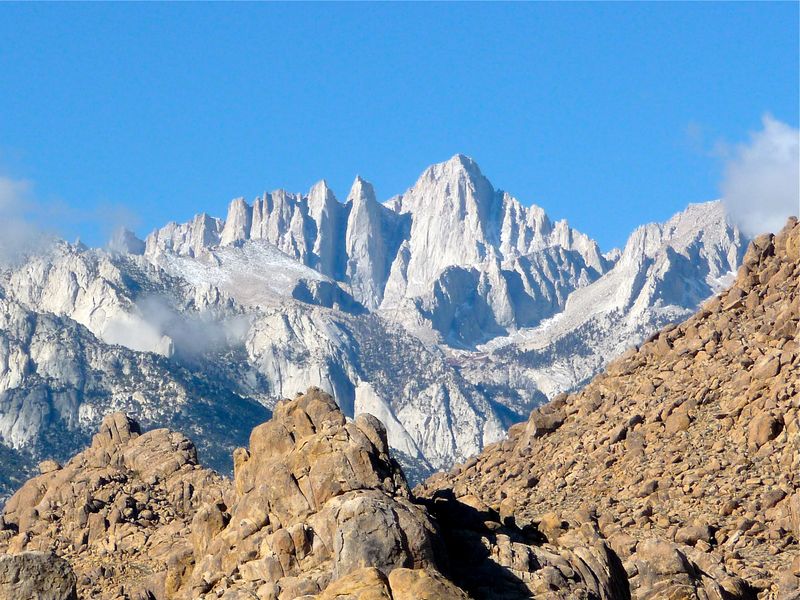
Claiming the title of highest peak in the contiguous United States, Mount Whitney reaches 14,505 feet into the California sky. This granite giant sits on the eastern edge of Sequoia National Park, creating a dramatic backdrop for both desert and forest landscapes.
What makes Whitney special is its accessibility – despite its impressive height, the main trail doesn’t require technical climbing skills. Thousands attempt the summit each year, though permits are strictly limited to protect the fragile ecosystem.
If you’re planning a visit, the contrast between Whitney and nearby Death Valley (the lowest point in North America) makes for an incredible day trip – you can literally go from the highest to lowest points in the continental US in just a few hours!
6. Mount Shasta
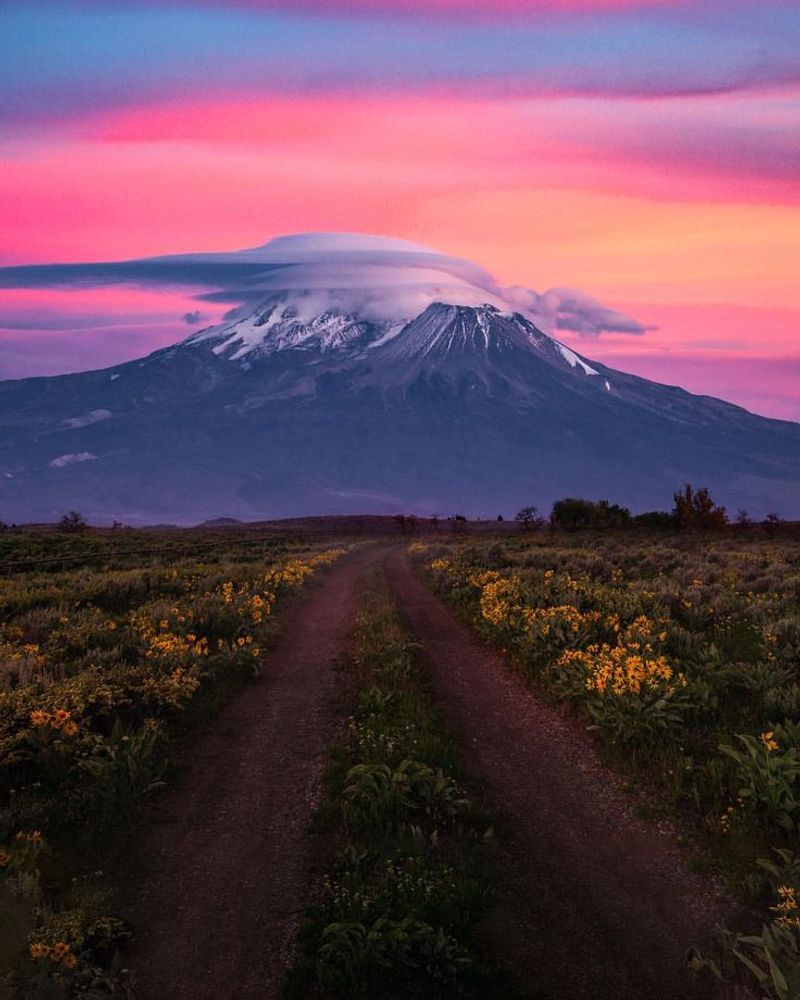
Rising dramatically from relatively flat surroundings, Mount Shasta commands attention as a solitary giant in Northern California. This 14,179-foot volcanic peak often creates its own weather patterns, with clouds swirling around its summit even on clear days.
Spiritual seekers have long been drawn to Shasta, believing it contains special energy vortexes. The mountain features seven glaciers and numerous waterfalls cascading down its slopes during spring melt.
Indigenous tribes considered Shasta sacred, and their legends tell of a hidden city within the mountain. Whether you believe the spiritual claims or not, there’s something undeniably magical about watching the alpenglow turn Shasta’s white peak to brilliant pink and orange at sunset.
7. Mount Hood
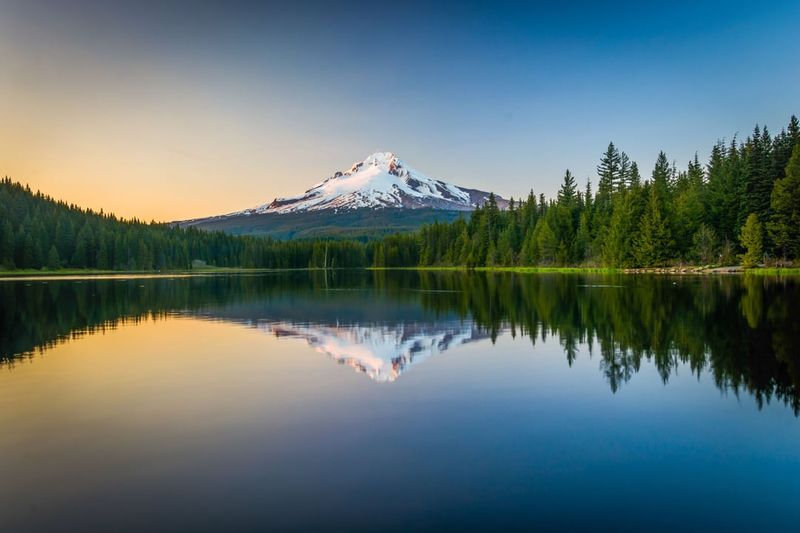
Just 60 miles from Portland, Mount Hood serves as Oregon’s highest peak and a year-round playground for outdoor enthusiasts. This 11,249-foot stratovolcano holds twelve named glaciers that feed the rivers flowing through the lush forests at its base.
Timberline Lodge, a historic mountain retreat on Hood’s southern slope, offers skiing even in summer months. The mountain’s relatively easy access makes it one of America’s most climbed glaciated peaks, though its weather can change dramatically without warning.
Did you know Mount Hood has erupted within the last two centuries and is considered Oregon’s most likely volcano to erupt? Despite this, its slopes host orchards and vineyards that thrive in the volcanic soil, producing some of the region’s best fruits and wines.
8. Mount Katahdin
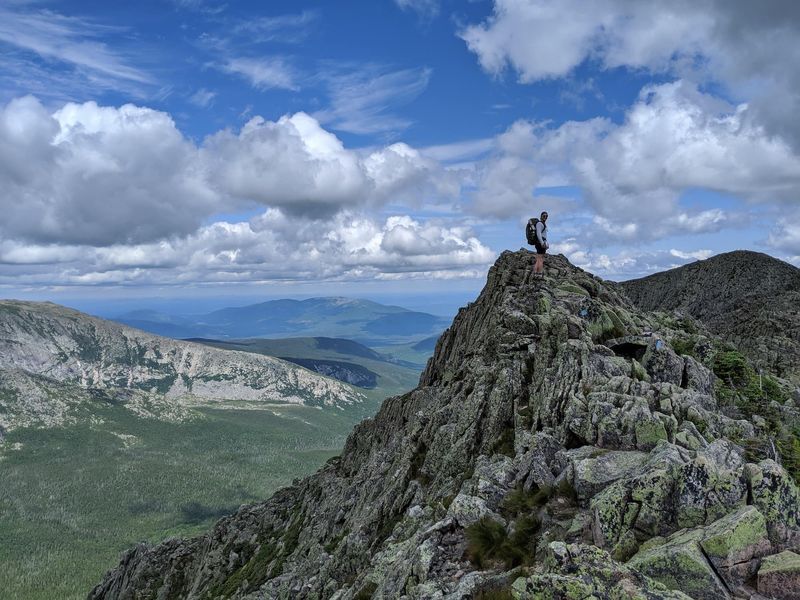
Marking the northern terminus of the Appalachian Trail, Mount Katahdin stands as Maine’s highest peak and the crown jewel of Baxter State Park. Native Americans named it “Katahdin,” meaning “The Greatest Mountain” – a fitting title for this 5,269-foot granite monolith.
Unlike western peaks, Katahdin rises from dense forests rather than high plains, making it seem even more imposing. The mountain’s unique Knife Edge trail offers one of the most thrilling hikes in the eastern US, with drops of thousands of feet on either side of a narrow ridge.
Though not as tall as western mountains, Katahdin’s northern location means its summit experiences arctic-like conditions. The view from the top spans millions of acres of virtually untouched wilderness, dotted with countless lakes and ponds.
9. Mount Mitchell

Rising 6,684 feet above sea level, Mount Mitchell claims the title of highest peak east of the Mississippi River. Located in North Carolina’s Black Mountains, this ancient peak formed over 400 million years ago, making it much older than the Rockies or Sierra Nevada.
The mountain’s unique ecosystem resembles what you’d find in Canada, with spruce-fir forests and cool temperatures year-round. A paved road leads nearly to the summit, making it accessible to visitors who might not otherwise experience such heights.
Though named after professor Elisha Mitchell who fell to his death while exploring the mountain in 1857, indigenous people knew it as “Attakulla” long before. The observation deck at the top offers spectacular 360-degree views across multiple states on clear days.
10. Pikes Peak

Inspiring the words to “America the Beautiful,” Pikes Peak rises majestically to 14,115 feet above Colorado Springs. This iconic mountain stands alone rather than as part of a range, making its massive presence even more striking against the horizon.
Unlike many tall peaks, Pikes Peak offers multiple ways to reach its summit – by car on the scenic highway, aboard the historic cog railway, or hiking the challenging 13-mile Barr Trail. The view from the top spans from the Great Plains to the Continental Divide.
When Katharine Lee Bates reached the summit in 1893, the panoramic vista moved her to write the poem that became our beloved patriotic song. The mountain hosts the famous Pikes Peak International Hill Climb, a race where drivers navigate 156 turns while climbing 4,720 feet!
11. Mount Washington
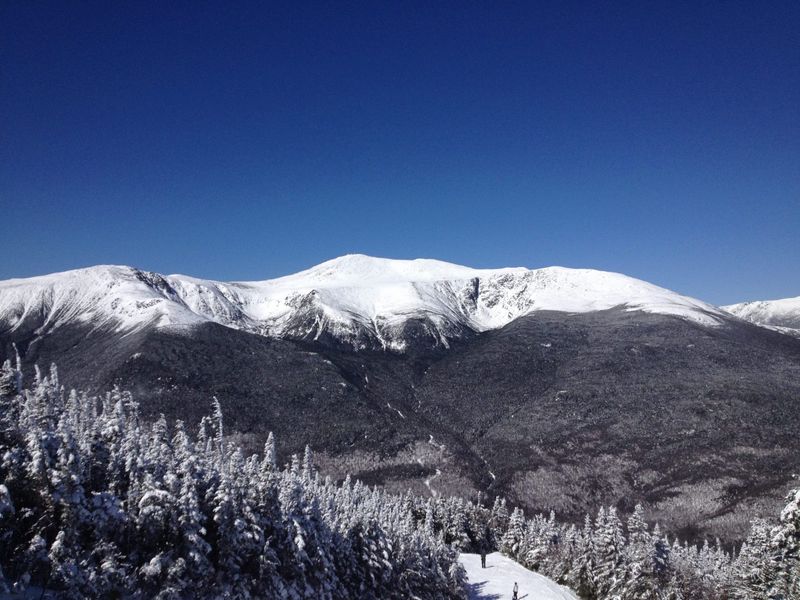
Despite its modest 6,288-foot height, Mount Washington boasts some of the most extreme weather on Earth. This New Hampshire peak once held the world record for highest wind speed ever recorded on land – a mind-boggling 231 mph!
The mountain’s unique position at the convergence of several storm tracks creates its notoriously unpredictable conditions. Hikers can experience all four seasons in a single day, even in summer. The historic cog railway that climbs to the summit dates back to 1869, making it the world’s first mountain-climbing train.
Alpine gardens near the top contain rare plants that survive nowhere else in the region. When visiting, don’t miss the opportunity to mail a postcard from the summit post office with its special “Top of New England” postmark!
12. Haleakalā
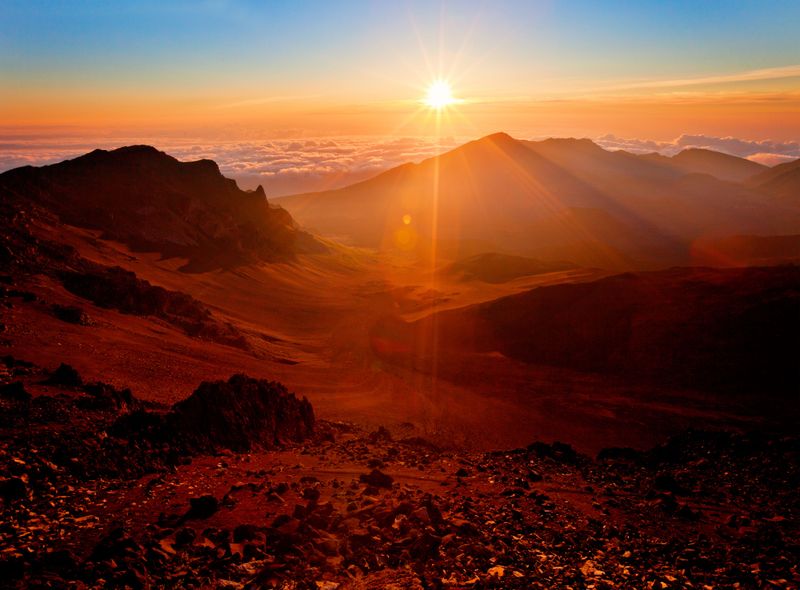
Rising from the ocean to 10,023 feet, Haleakalā dominates the landscape of Maui, Hawaii. This massive shield volcano forms more than 75% of the island, with a crater so vast that Manhattan could fit inside it.
The name means “house of the sun” in Hawaiian, referencing the legend of how the demigod Maui snared the sun to make days longer. Sunrise viewings from the summit have become a bucket-list experience, with the crater filling with golden light as clouds drift below.
Within the national park, over 30 species of plants exist nowhere else on Earth. The silversword, a remarkable plant that lives up to 90 years but blooms only once before dying, creates an otherworldly landscape against the red volcanic soil. The clear mountain air also makes Haleakalā one of the world’s best places for stargazing.
13. Glacier Peak

Hidden deep in Washington’s Glacier Peak Wilderness, this 10,541-foot volcano remains one of the Cascade Range’s most remote and pristine mountains. Unlike its more accessible neighbors, Glacier Peak requires serious commitment to even glimpse its snow-capped summit.
The mountain hosts more active glaciers than any other peak in the lower 48 states outside of Mount Rainier. Wildflower meadows surround alpine lakes, creating stunning foregrounds for photographs of the peak.
Though less known than other Cascade volcanoes, Glacier Peak is among the most active and potentially dangerous. Indigenous peoples called it “Dakobed” and considered it a sacred place. The mountain’s isolation has protected it from development, preserving an ecosystem that feels truly wild and untouched.
14. Mount Mansfield

Vermont’s highest peak resembles the profile of a human face when viewed from the east, with distinct features named the Forehead, Nose, Chin, and Adam’s Apple. Mount Mansfield rises to 4,393 feet, offering spectacular views across the Green Mountains and into neighboring states and Canada.
During winter, the mountain transforms into Stowe Mountain Resort, one of the East’s premier ski destinations. Summer brings hikers to the alpine zone atop the mountain, where rare Arctic plants survived since the last ice age.
The Long Trail, America’s oldest long-distance hiking path, traverses Mansfield’s summit ridge. Though not as tall as western mountains, Mansfield’s location in the northeast means its summit experiences harsh winter conditions, with rime ice forming fantastic sculptures on the vegetation and rocks.
15. Longs Peak
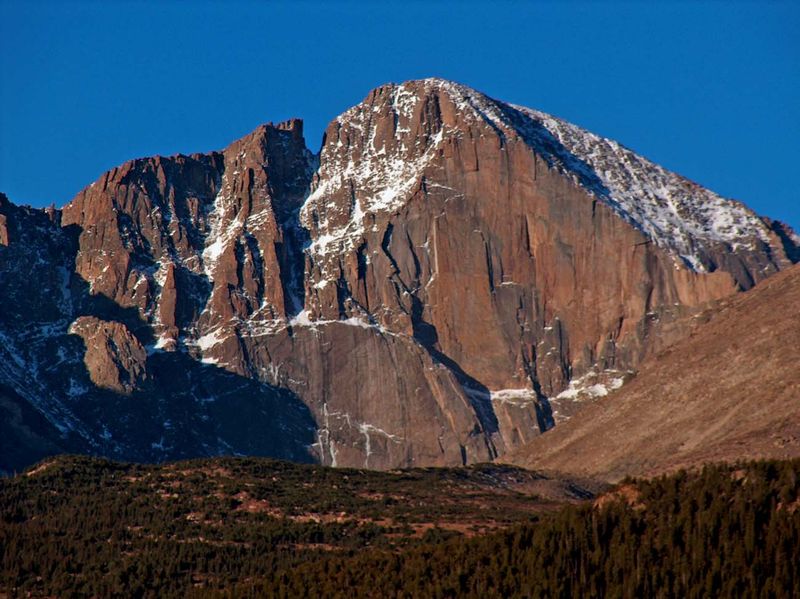
Towering above Rocky Mountain National Park at 14,259 feet, Longs Peak presents one of Colorado’s most challenging and rewarding climbs. Its distinctive flat top and sheer vertical east face (known as the Diamond) make it instantly recognizable from miles away.
The standard route to the summit, the Keyhole Route, involves 15 miles round-trip with serious exposure and climbing that requires hands and feet. Starting before dawn is essential, as afternoon thunderstorms make the mountain dangerous.
Though thousands attempt the climb each year, fewer than half reach the summit. Native Americans called it “Nesotaieux” or “two guides” for the dual peaks that appear when viewed from certain angles. The mountain was named after Major Stephen Long, who explored the area in 1820 but never actually climbed it!
16. Mount Baker

Known for holding the world record for most snowfall in a single season (1,140 inches in 1998-99), Mount Baker is a snow-lover’s paradise in Washington’s North Cascades. This 10,781-foot active volcano is covered by ten glaciers that create a dazzling white crown visible from as far away as Vancouver, Canada.
Winter brings skiers and snowboarders to the mountain’s legendary powder. During summer, hikers explore meadows bursting with wildflowers while mountaineers test their skills on glacial routes.
Indigenous Lummi people called it “Koma Kulshan” meaning “White Sentinel.” Despite being one of the most monitored volcanoes in the Cascade Range due to increased activity in the 1970s, Baker continues to attract outdoor enthusiasts year-round who are drawn to its pristine beauty and challenging terrain.
17. Mount Elbert
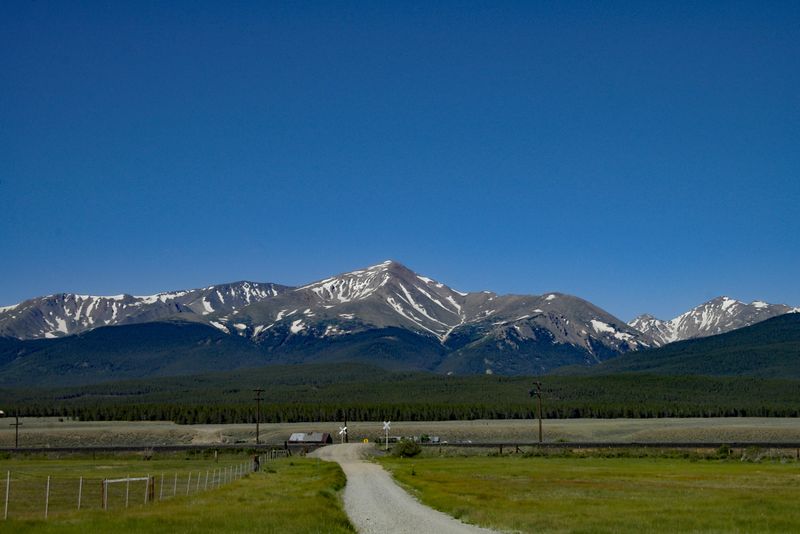
Standing as Colorado’s highest peak and the second-highest in the continental United States, Mount Elbert reaches 14,440 feet into the Rocky Mountain sky. Despite its impressive height, Elbert offers relatively gentle slopes compared to many Colorado fourteeners, making it accessible to determined hikers without technical climbing skills.
The standard route gains nearly 5,000 feet of elevation over 9 miles round trip. Multiple false summits test hikers’ determination before reaching the true top, where views extend across much of central Colorado.
Named after Samuel Elbert, a territorial governor of Colorado, the mountain was once the subject of a humorous height rivalry. Supporters of nearby Mount Massive would build stone piles on their peak trying to make it taller than Elbert, only to have Elbert fans dismantle them!
18. Mauna Kea

Though its summit stands 13,803 feet above sea level, Mauna Kea actually measures over 33,000 feet from its true base deep beneath the Pacific Ocean – making it technically taller than Mount Everest! This dormant volcano on Hawaii’s Big Island hosts the world’s largest astronomical observatory, with telescopes from 11 countries taking advantage of the exceptionally clear air.
Winter often brings snow to the summit, creating the surreal opportunity to go from tropical beaches to snowboarding in the same day. The mountain’s name means “White Mountain” in Hawaiian, referring to its snow-capped appearance.
Sacred to native Hawaiians as the home of the snow goddess Poliʻahu, Mauna Kea features over 300 shrines and burial sites. The summit area contains Lake Waiau, one of the world’s highest alpine lakes, considered spiritually significant in Hawaiian culture.
19. Wheeler Peak
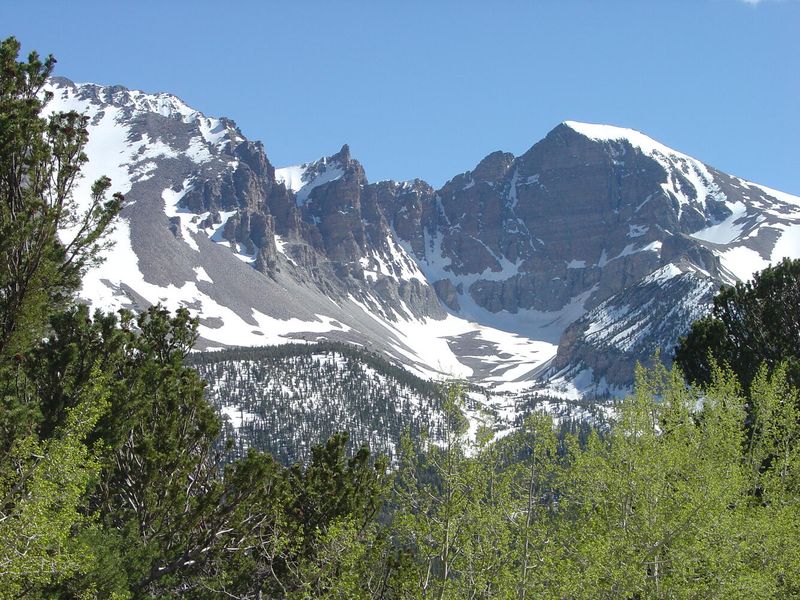
Rising dramatically above the Great Basin Desert, Wheeler Peak stands as Nevada’s second-highest point at 13,065 feet. This mountain in Great Basin National Park creates its own ecosystem, with alpine lakes, ancient bristlecone pine forests, and even a small glacier – surprising features in one of America’s driest states.
The 8.6-mile round-trip summit trail rewards hikers with views spanning four states. Along the way, you’ll pass through distinct life zones, from desert scrub to subalpine forest.
Near the mountain’s base grows a bristlecone pine estimated to be over 5,000 years old – among the oldest living organisms on Earth! The area’s extreme isolation from major cities also creates some of the darkest night skies in the country, making it a paradise for stargazers.
20. Mount Saint Helens

Forever changed by its catastrophic 1980 eruption, Mount Saint Helens offers a fascinating glimpse into nature’s destructive power and remarkable recovery. Once a perfectly symmetrical cone reaching 9,677 feet, the volcano now stands at 8,366 feet with a massive crater where its north side collapsed.
Hiking to the summit provides views directly into the steaming crater, where a lava dome continues to grow. The surrounding landscape shows incredible ecological rebirth, with plants and animals returning to areas once completely devastated.
Scientists have learned invaluable lessons about volcanic activity and forest recovery by studying Saint Helens. The Johnston Ridge Observatory, named for volcanologist David Johnston who perished in the eruption, offers excellent educational exhibits about the mountain’s dramatic history and ongoing changes.
21. Black Elk Peak
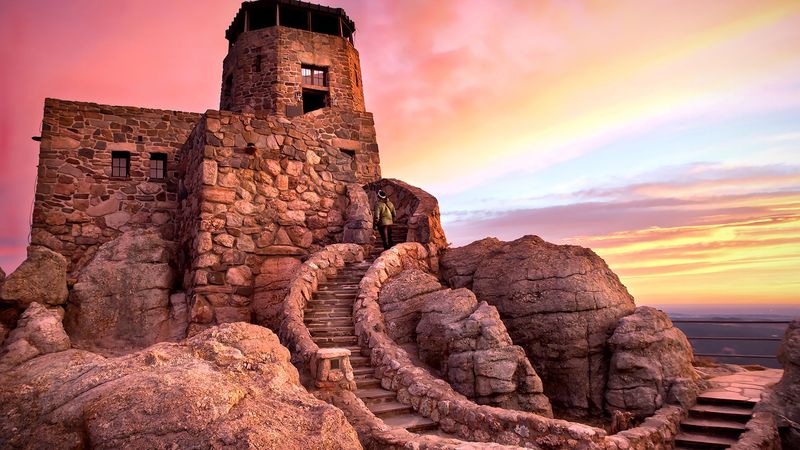
Rising from the forested landscape of South Dakota’s Black Hills, Black Elk Peak (formerly Harney Peak) reaches 7,242 feet, making it the highest point east of the Rockies and west of the Appalachians. This granite summit offers hikers a 360-degree panorama across four states.
The historic stone fire lookout tower at the top was built by the Civilian Conservation Corps in the 1930s and adds a distinctive human element to the natural landscape. Surrounding the peak are the unique granite spires and formations that make the Black Hills famous.
Renamed in 2016 to honor the Lakota holy man Black Elk, this mountain holds spiritual significance for many Native American tribes. The peak sits within the Black Elk Wilderness, offering visitors a chance to experience the landscape much as it appeared to early inhabitants of the region.
22. Mount Olympus
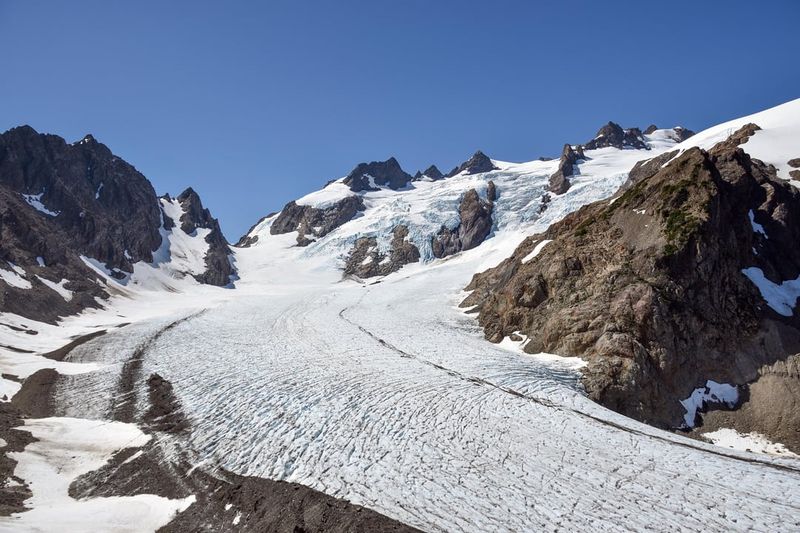
Hidden within Washington’s rainforest peninsula, Mount Olympus receives over 200 inches of precipitation annually, creating one of America’s most unique mountain environments. Though modest in height at 7,980 feet, Olympus supports massive glaciers thanks to the tremendous snowfall.
The mountain sits deep within Olympic National Park, requiring a multi-day expedition through temperate rainforest to reach its base. Massive Sitka spruce and western hemlock trees create a primeval atmosphere along the approach, with some trees over 1,000 years old.
Named after the home of Greek gods by British explorer John Meares who spotted it from the Pacific Ocean in 1788, Olympus remains one of the most isolated major peaks in the lower 48 states. The surrounding ecosystem is so unique that it contains plants and animals found nowhere else on Earth.
23. Half Dome
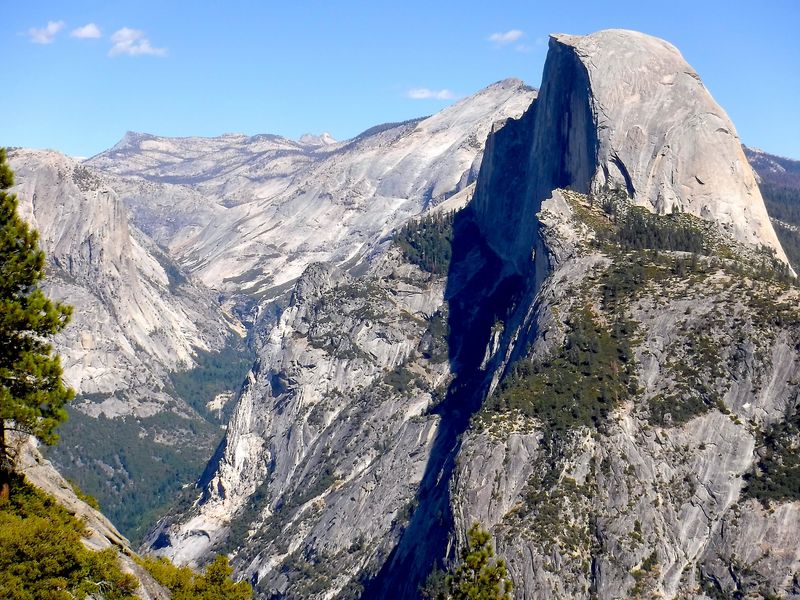
Though not technically a mountain but rather a granite dome with one face so steep it appears to have been sliced in half, Half Dome stands as Yosemite National Park’s most iconic landmark. Rising nearly 5,000 feet above the valley floor, its distinctive profile has inspired photographers, painters, and climbers for generations.
The grueling 16-mile round-trip hike to the summit includes the famous cable route, where hikers pull themselves up the final 400 feet using steel cables. From the top, Yosemite Valley spreads out in a panorama that ranks among America’s most spectacular views.
Geologists believe Half Dome was formed not by glacial action as once thought, but by exfoliation – the process where layers of rock peel away from the surface. The first recorded ascent was in 1875, a remarkable achievement considering the equipment available at the time!
